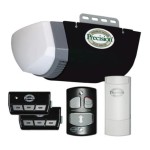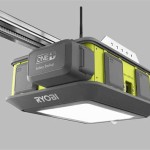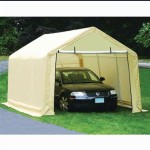Here's an article focusing on overhead garage door spring replacement:
Overhead Garage Door Spring Replacement: A Comprehensive Guide
Overhead garage doors rely on a complex system of components working in unison for smooth and safe operation. Among the most crucial, and often overlooked, are the springs. These springs, under tremendous tension, counterbalance the weight of the door, enabling it to be lifted and lowered with relative ease. When a garage door spring fails, it can render the entire system inoperable and, more importantly, pose a significant safety hazard. Understanding the types of springs, recognizing the signs of failure, and knowing when to seek professional help are vital for maintaining a functioning and safe garage door.
Garage door springs are not a universal design. Two primary types dominate residential and commercial applications: torsion springs and extension springs. Each type operates differently and requires specific knowledge and tools for replacement. Identifying the correct spring type is the first step in addressing any spring-related issue.
Torsion springs are mounted horizontally above the garage door opening. They work by winding and unwinding, storing rotational energy to counterbalance the door's weight. These springs are generally considered more durable and safer than extension springs. When a torsion spring breaks, it typically stays in place due to the tension still present in the remaining spring. However, this should not be misinterpreted as a lack of danger; the remaining spring still holds a considerable amount of force.
Extension springs, on the other hand, are mounted along the horizontal tracks on either side of the garage door. They extend and contract as the door moves, providing the necessary lifting force. Extension springs are often equipped with safety cables that run through the center of the spring. These cables are designed to contain the spring if it breaks, preventing it from becoming a projectile. However, even with safety cables, replacing extension springs remains a potentially hazardous task.
The lifespan of a garage door spring is typically measured in cycles, where one cycle represents a complete opening and closing of the door. The average lifespan is around 10,000 cycles, but this can vary depending on factors such as the quality of the spring, the frequency of use, and the level of maintenance. Regular lubrication can extend the life of the springs and reduce the risk of premature failure.
Recognizing the Signs of Garage Door Spring Failure
Identifying a failing or broken garage door spring is essential for preventing further damage to the door and ensuring the safety of individuals using the garage. Several telltale signs indicate a problem with the springs. One of the most obvious signs is a visible break in the spring itself. This can manifest as a distinct gap or separation in the coils. A broken spring will often be accompanied by a loud snapping or banging sound.
Another common sign is a garage door that is difficult to open or close. If the door feels unusually heavy or requires excessive effort to operate, it may indicate that the springs are no longer providing the necessary counterbalance. In some cases, the door may only open partially or may struggle to stay open. The door may also appear lopsided, with one side higher than the other, indicating that one of the springs has failed or is significantly weaker than the other.
Unusual noises during operation can also point to spring problems. Squeaking, grinding, or popping sounds may indicate that the springs are worn or damaged. These noises are often caused by friction between the coils or between the spring and its mounting hardware. Visual inspection of the springs is always recommended when these sounds are noticed.
A garage door that closes too quickly or slams shut is another indication of a spring issue. When the springs are functioning correctly, they provide a controlled descent. When they fail, the door's weight is no longer adequately counterbalanced, resulting in a rapid and uncontrolled closing motion. This can be particularly dangerous and can cause damage to the door, the garage floor, or anything in the path of the door.
Finally, excessive bouncing or shaking during operation can also signal a problem with the springs. This can occur when one of the springs is significantly weaker than the other, causing an imbalance in the system. The door may vibrate excessively as it moves, and the overall operation may feel unstable.
The Dangers of DIY Spring Replacement
While some home improvement projects are suitable for do-it-yourself enthusiasts, garage door spring replacement is generally not one of them. The high tension stored in these springs presents a significant safety risk, and improper handling can result in serious injury or even death. There are documented cases of severe lacerations, broken bones, and even fatalities resulting from attempted DIY spring replacements.
Garage door springs are under extreme tension, and specialized tools and techniques are required to safely release and re-tension them. Attempting to release the tension without the proper tools can cause the spring to snap violently, resulting in serious injury. Even seemingly minor adjustments can have significant consequences if not performed correctly.
Furthermore, improper installation of new springs can lead to premature failure and further safety hazards. The springs must be properly matched to the weight and size of the garage door, and the tension must be carefully calibrated to ensure smooth and balanced operation. Incorrect installation can also damage other components of the garage door system, such as the cables, rollers, and tracks.
Even if the replacement seems successful initially, there is a risk of latent problems that may not become apparent until later. These problems can include uneven door movement, excessive strain on the opener mechanism, and premature wear and tear on the springs. Addressing these issues can require further repairs and expenses, ultimately negating any perceived cost savings from attempting a DIY replacement.
The potential for serious injury and the risk of further damage to the garage door system far outweigh any potential cost savings from a DIY spring replacement. It is always advisable to hire a qualified and experienced garage door technician to handle this type of repair. Professionals have the necessary training, tools, and expertise to safely and effectively replace garage door springs.
The Professional Approach to Spring Replacement
A professional garage door technician will follow a specific protocol to ensure the safe and effective replacement of garage door springs. This protocol typically involves several key steps. First, the technician will thoroughly inspect the entire garage door system to identify any other potential problems, such as worn rollers, frayed cables, or damaged tracks. This comprehensive assessment helps to ensure that all necessary repairs are addressed at the same time, preventing future issues.
Next, the technician will carefully measure the existing springs to determine the correct replacement size and type. This is crucial for ensuring that the new springs are properly matched to the weight and size of the garage door. Using the wrong springs can result in improper balance, premature wear, and potential safety hazards. The technician will consider wire gauge, inside diameter, and length to ensure proper matching.
Before removing the old springs, the technician will typically secure the garage door in place to prevent it from falling during the replacement process. This may involve using clamps, supports, or other specialized tools. Securing the door is essential for preventing accidental injury and damage to the door or surrounding structures.
Using specialized tools, the technician will carefully release the tension from the old springs. This is a critical step that requires precise control and expertise. The technician will use winding bars to gradually unwind the springs, ensuring that the tension is released in a controlled manner. Improperly releasing the tension can cause the springs to snap violently, posing a serious safety risk.
Once the old springs have been safely removed, the technician will install the new springs, ensuring that they are properly aligned and secured. The technician will then carefully wind the new springs to the correct tension, using winding bars and a tension gauge. The tension must be precisely calibrated to ensure smooth and balanced operation of the garage door.
After the new springs have been installed and tensioned, the technician will test the operation of the garage door to ensure that it opens and closes smoothly and evenly. The technician will also check the balance of the door and make any necessary adjustments to ensure that it is properly balanced. This is essential for preventing strain on the opener mechanism and ensuring the longevity of the springs.
Finally, the technician will lubricate all moving parts of the garage door system, including the springs, rollers, hinges, and tracks. Lubrication helps to reduce friction, prevent wear and tear, and ensure smooth and quiet operation. The technician may also provide recommendations for ongoing maintenance to help extend the life of the garage door system.
By following this comprehensive protocol, a professional garage door technician can safely and effectively replace garage door springs, ensuring the continued smooth and safe operation of the garage door system. Choosing a qualified and experienced technician is essential for achieving optimal results and minimizing the risk of injury or damage.

Garage Door Torsion Spring Replacement How To Youtube

Diy Garage Door Torsion Spring Replacement A1 Experts

How To Install A Single Torsion Spring Assembly

Garage Door Spring Replacement When And Why It S Necessary Moore Overhead

Spring Repair And Replacement Habprogaragedoors Com

Understanding Garage Door Springs Torsion Vs Extension Overhead Company Of Battle Creek Jackson And Ann Arbor

Torsion Springs For Garage Doors

Garage Door Spring Replacement Repair Guide Clopay

How To Safely Repair Overhead Garage Door Springs

10 Signs You Need A Garage Door Spring Replacement








